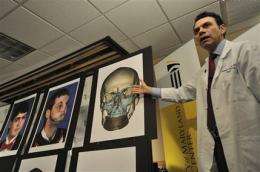Virginia man injured in gun accident gets new face (Update)

(AP) -- After 15 years of wearing a mask and living as a recluse, a 37-year-old Virginia man disfigured in a gun accident got a new face, nose, teeth and jaw in what University of Maryland physicians say is the most extensive face transplant ever performed.
Richard Lee Norris of Hillsville is recovering well after last week's surgery, beginning to feel his face and already brushing his teeth and shaving, University of Maryland Medical Center officials announced Tuesday. He's also regained his sense of smell, which he had lost after the accident.
Norris, who was selected from among five possible candidates for the surgery, has been living as a recluse, doing his shopping at night. It's hoped the transplant will give him his life back, said Dr. Eduardo Rodriguez, the lead surgeon.
"It's a surreal experience to look at him. It's hard not to stare. Before, people used to stare at Richard because he wore a mask and they wanted to see the deformity," Rodriguez said. "Now, they have another reason to stare at him, and it's really amazing."
Rodriguez showed a 1993 prom photo of Norris, "as we all want to be remembered," beside a pre-transplant photo of Norris' shortened face with a sunken mouth and flattened nose. He then revealed a photo of Norris taken on Monday, where his face appears ordinary, other than stiches along his hairline and neck and scarring around his eyelids. Although he now has the donor's face, he doesn't resemble the donor, Rodriguez said.
"It's a combination of two individuals, a true blend," he said.
Norris' vision was largely unaffected by the accident. Because of numerous reconstructive surgeries, his forehead and neck were mostly scar tissue. Norris had no teeth, no nose and only part of his tongue. He was still able to taste but could not smell.
"He could not smell for the past 15 years, and that was the most dramatic thing - immediately, on day three, he could finally smell," Rodriguez said.
Doctors gave few details about the donor, citing the family's desire for privacy. They said the donor's organs went to several people. But the donor's family was consulted specifically about donating the face, said Charles Alexander, president of the Living Legacy Foundation. He said that consenting to be an organ donor does not automatically extend to face donations.
The 36-hour operation was the most extensive because it included transplantation of the teeth, upper and lower jaw, a portion of the tongue and all facial tissue from the scalp to the base of the neck, Rodriguez said. Because it included so much facial tissue, the incisions are farther back and less visible, he said.
The most dramatic moment came when the team had finished removing all the previous attempts at reconstruction. All Norris had left was a bit of tongue and minimal protection for his eyes. Rodriguez called it the point of no return.
"At that point, we had to be successful," he said. Norris will require minor revisions, but those will be outpatient procedures, he said.
It was the 23rd face transplant since doctors began doing the procedure seven years ago. The first full face transplant was performed in France in 2005 on a woman who was mauled by her dog. The Cleveland Clinic performed the first face transplant in the U.S. in 2008.
The Department of Defense has been funding some face and hand surgeries with the goal of helping wounded soldiers. More than 1,000 troops have lost an arm or leg in Afghanistan or Iraq, and the government estimates that 200 troops might be eligible for face transplants.
The University of Maryland's research on transplants was funded by a grant from the Office of Naval Research, and doctors said they hope to begin operating soon on military patients.
Researchers found that transplants involving large amount of bone marrow with its own blood supply saw fewer or no rejections, transplant surgeon Dr. Rolf Barth said. Norris will have to take immunosuppression drugs for the rest of his life to keep his body from rejecting the donated face, but the jaw transplant could mean he will need less and may be able to go off steroids, he said.
"This was the perfect patient to put into practice what we had discovered in the laboratory," Barth said.
Officials provided little detail on Norris or the circumstances of the accident that took his face. He graduated from high school in his small southwest Virginia hometown in 1993 and was employed at the time of the accident. Since then, he has lived with his parents and has not had a full-time job, Rodriguez said.
"This accidental injury just destroyed everything. The rest of his friends and colleagues went on to start getting married, having children, owning homes," Rodriguez told The Associated Press. "He wants to make up for all of that."
©2012 The Associated Press. All rights reserved. This material may not be published, broadcast, rewritten or redistributed.


















